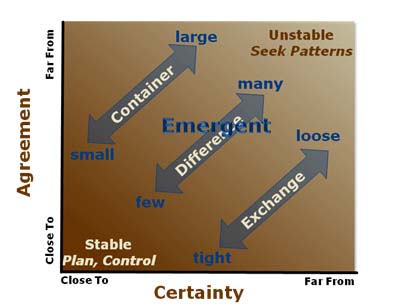Human System Dynamics: Complexity in a rubber value chain
Development projects have been seeking to positively influence complex systems, such as value/market chains for many years. Working with these large systems has always been a challenge, and has generated many approaches and models designed to guide development projects.
At the same time, the field of organizational development has been struggling with the challenge of working with complex systems inside large organizations. One tool coming out of organizational development is Human System Dynamics (HSD). HSD uses metaphors from the physical, mathematical, and computer sciences to help change agents understand what is happening in dynamic interactions in large groups and has the advantage of being a “meta model” for working with complex systems.
HSD is primarily a way of making sense of patterns. Life is about patterns – seeing patterns, breaking patterns, making patterns. This is what we do as humans. Patterns are similarities, differences and relationships that have meaning across space and time. HSD concepts and tools help us to understand and recognize the patterns that emerge from instability when people work or live together in complex systems. HSD is based on the study of complexity science and chaos theory which focus on the surprising behavior of Complex Adaptive Systems (CAS). HSD in action means that you can see patterns as they emerge and find the solution that best fits the system.
 The HSD approach establishes a landscape map for determining the level of complexity of a system and three core concepts for influencing it.
The HSD approach establishes a landscape map for determining the level of complexity of a system and three core concepts for influencing it.
The three HSD concepts applied to a rubber value chain in this presentation are (HSD Institute, 2012. Used with Permission):
- Containers - boundaries that bring and hold a group together;
- Differences &- factors that create and shape the patterns of behavior; and
- Exchanges - connections and feedback loops among system actors and stakeholders.
By adopting a facilitative approach to working with the value chain, players in the value chain were able to:
- Explore their differences and identify the most significant ones, which if addressed, would significantly alter the patterns within the system;
- Identify the key exchanges and feedback loops to amplify in order to improve the supportive relationships within the value chain; and
- Enlarge and create new containers that increased communication and allowed players in the value chain to work together in ways they had not before.
The results of these interventions were changes in the system that benefited both the smallholder rubber producers and the factories refining rubber for export markets. Farmers received almost double the price by weight yielding an increase in income of about 20%, and the factories gained a supply of good quality rubber.
Although the actual interventions in this value chain case were not extraordinary, they show that application of the HSD approach is applicable to value chains and may provide an analytical model useful for working with more complex value chains.


